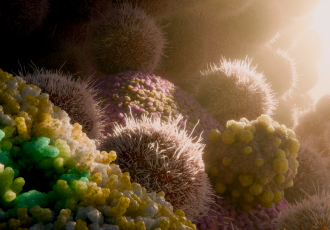13. Aug. 2024
Scientists at CEITEC Masaryk University have taken a major step forward in the battle against drug-resistant bacterial infections and cancer at the cellular level. They have designed special peptides capable of breaching the protective membrane barrier by forming barrel-shaped pores that allow molecules to pass uncontrollably across the membrane, in and out of the cell, leading to rapid cell death. Such pore-forming peptides are therefore seen as promising candidates for alternative therapeutics.
Biological membranes are semipermeable barriers that protect the cell of all living organisms. They allow certain molecules to pass through while blocking others, maintaining a stable internal environment within the cell. Peptides are small proteins consisting of only a few amino acids, typically 10 to 50. Certain peptides have the unique ability to insert into the membrane and spontaneously come together to form nano-sized structures that span the membrane. When these peptides arrange themselves in a particular shape, they can create pores in the membrane. One such special shape is called barrel-stave pore, in which the peptides lie side by side along the pore like the staves in the barrel, with a water channel through a membrane. Such pores allow molecules to pass freely through the membrane. This uncontrolled passage can lead to cell death because the cell can no longer maintain its stable internal environment. Until now, it has been difficult to design such peptides.
In a paper recently published in the Journal of Medicinal Chemistry and featured on the journal’s cover, Rahul Deb and Robert Vácha, in collaboration with Miroslav Boudný and Marek Mráz, from CEITEC Masaryk University, designed the peptides and systematically investigated the effect of specific mutations on the peptide’s activity against bacteria and cancer cells and toxicity to human cells. Using computer simulations supported by biophysical experiments, they found that for the peptides to be highly effective, they must be specifically tuned to be attracted to the bacterial and cancer cell membranes before pore formation. Therefore, it appeared that both membrane affinity and pore formation had to be tuned simultaneously to increase the effectiveness of the peptides.
Rahul Deb explains: “To make the pore-forming peptides more effective against bacteria, we increased their positive charge by incorporating certain amino acids. However, these mutations must be done carefully to avoid losing their pore-forming ability. Specific mutations make the peptides pH-sensitive, which we have exploited to target cancer cells because tumours have an acidic microenvironment.”
With the help of collaborators from CNRS in France, Sapienza University of Rome, BIOCEV, and Palacký University, the team observed improved antibacterial activity and low toxicity. Notably, the peptides showed strong anti-infective properties in a preclinical mouse model of Acinetobacter baumannii infection, thanks to collaborators from the University of Pennsylvania.
Marek Mráz adds: “We saw a boost in anticancer activity when we lowered the pH of the culture media below the physiological pH, suggesting a "therapeutic window" for selective cancer treatment.”
“The main advantage of our designs is that we now understand the role of each part of the peptide sequence. This allows us to fine-tune them for specific applications, whether it is fighting bacteria or cancer. Our work highlights the potential of computationally designed peptides as new therapeutics,” Robert Vácha concludes.
This research was supported by the National Institute of Virology and Bacteriology Exceles project.


 Share
Share


